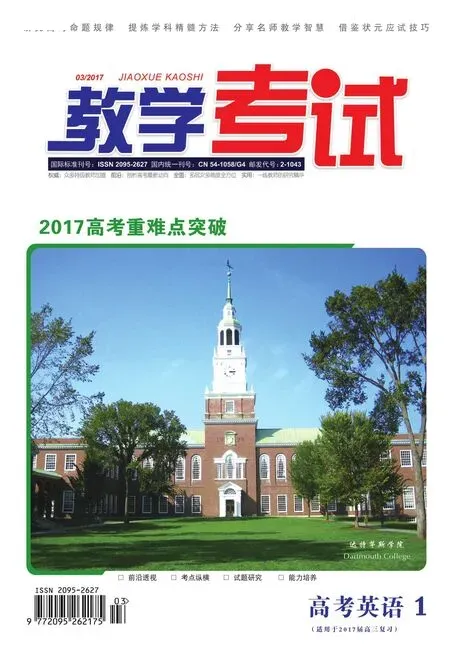特殊句式重难点点拨
甘肃 董耀忠
特殊句式重难点点拨
甘肃 董耀忠
高中英语中,特殊句式主要指强调句、倒装句、反义疑问句、感叹句、祈使句以及插入语和省略等。下面,基于句子基本结构,笔者对几种重要的特殊句式考查的重难点予以归纳。
一、特殊句式高考真题链接
【考例1】(改编自2015天津卷,3)Only when Lily walked into the off ce_______she realize that she had left the contract at home.
【解析】did。部分倒装结构,要“主倒从不倒”,即主句倒装从句不倒装。句意为:只有当Lily走进办公室的时候,她才意识到她把合同忘在家里了。
【考例2】(改编自2015湖南卷,21)It was when we were returning home________I realized what a good feeling it was to have helped someone in trouble.
【解析】that。此句为“It is(was)+被强调部分+that(who)……”强调句结构。句意为:正是在我们回家的时候,我才意识到帮助别人于危难之时的感觉是多么令人愉悦。
【考例3】(2016上海卷,32)I was so impressed by_______self ess she was.
【解析】how。“how self ess she was”作介词by的宾语,为how修饰形容词self ess的感叹句结构。
【考例4】(2016全国卷Ⅲ,61)In much of Asia,especially the so-called “rice bowl” cultures of China,Japan,Korea,________Vietnam,food is usually eaten with chopsticks.
【解析】and。列举了一些亚洲国家,它们之间是并列关系,and为表示并列关系的并列连词。
二、句子结构要点简要归纳
英语的句子注重形合,而汉语的句子则注重意合,掌握了英语中正常的句式结构才能更好地理解和运用特殊句式。
1. 句子按使用目的可分为:陈述句、疑问句、祈使句和感叹句。例如:
He can hardly speak an English word. 他几乎连一个英语单词也讲不出来。(陈述句)
Is there anything wrong with your pen? 你的钢笔有问题吗?(一般疑问句)
Have a cup of tea,will you?来杯茶,好吗?(反义疑问句)
How f uently he speaks English!他英语讲得多流利啊!(感叹句)
【要点速测】When you’ve f nished with that book,don’t forget to put it back on the shelf,________you?(填will。祈使句的反义疑问句)
2. 句子按结构可分为:简单句、并列句和复合句。其中:
(1)只有一个主语(或并列主语)和一个谓语(或并列谓语)的句子叫简单句。有主谓、主谓宾、主系表、主谓双宾语、主谓复合宾语等结构。例如:
I gave her a book.我给她一本书。(主语+及物动词+间接宾语+直接宾语)
I saw our headmaster walk out.我看见我们的校长出去了。(主语+及物动词+宾语+宾补)
(2)含有两个或两个以上的独立的主谓结构或简单的句子,叫并列句。并列连词常有:
①表示并列关系的:and,both...and...,not only...but(also)...和as well as等。 如:He likes not only playing basketball,but also playing football.
②表示转折关系的:but,while,however,yet和still等。如:Tom was rich while his brother was very poor.
③表示选择关系的:or,or else,otherwise,either... or...,neither...nor和not...but...等。如:Either you come to my place or I go to yours.
④表示因果关系的:for,so和therefore等。如:He didn’t work hard,therefore he failed in the examination.
【要点速测】In some places women are expected to earn money_______men work at home and raise their children.(填while。while在此处表示“而……”,连接并列句,含有对比的意思)
3.复合句是由一个主句和一个或一个以上的从句构成。主要为名词性从句、定语从句和状语从句三大从句,其中衔接主从句的关联词语的选择是考查的重点。例如:
Don’t promise anything unless you are one hundred percent sure.(状语从句)
I’ll give you my friend’s home address,which is easy to f nd.(定语从句)
Tomorrow is Tom’s birthday. Have you got any idea where the party is to be held?(同位语从句)
【要点速测】We have some doubt________he can come here this afternoon.(填whether。引导同位语从句)
三、特殊句式重难点点拨
(一)强调句
1. 强调句的句型:It is/was+被强调部分(强调除句子谓语和定语以外的其他完整的句子成分) +that/who(被强调部分为人时用who)+其他……。例如:
It was in the park that Tom lost his watch.是在公园里Tom丢了他的表。(强调地点状语)
【要点速测】It is what you do rather than what you say_______matters.(填that。“what you do rather than what you say”为被强调的句子成分,是“matters”的主语)
2. 强调句的疑问句型:一般疑问句只须把is/was提到it前;其特殊疑问句结构中,若被强调的是特殊疑问词时,用“特殊疑问词+is/was+that...?”。例如:
What is it that you want me to do? 你想要我去做什么事?(what提问do的宾语,为被强调成分)
【要点速测】—________was it that he managed to pass TOEFL?
—Oh,he had studied English in the school for several years.(填How。根据上下文意,强调的是方式)
3. 被强调的部分为从句:除定语从句外,从句均可被强调,但原因状语从句若是由as,since等引导时,改为because引导即可。例如:
It was because she got up late that she missed the first bus.是因为她起迟了,所以错过了首趟班车。
4. “not...until...”在强调句中:应否定转移,形成“It is/was not until...that...”句式结构。例如:
It was not until I got of f the bus that I realized it.直到我下车才认出了它。
【要点速测】It wasn’t until nearly a month later_______I received the manager’s reply.(填that。强调not until引导的时间状语从句)
5. 强调句中的主谓一致:若被强调的是主语,则that/ who后面的谓语动词依然与该主语保持一致。例如:
It is I who am to blame.是我该受到责备。(原句为:I am to blame.)
【要点速测】It is not only I but also Jane who________tired of having one examination after another.(填is。被强调结构是由“not only...but also...”引导的并列成分,为原句的主语,应用“就近原则”)
6. 判断是否是强调句的原则:将句中的“it is/was”与“that”去掉,句子仍然完整。例如:
It was at f ve o’clock that the plane landed at the airport.是在五点的时候飞机在机场着陆了。(去掉“it was”和“that”,句子仍然完整)
【要点速测】Is it the years_______you worked in the factory________have a great ef fect on your literary works?(填when;that。when引导定语从句,“the years”为被强调成分)
(二)倒装句
1. 完全倒装:谓语动词完全放到主语之前形成的倒装。主要表现在:
(1)there be句型。例如:
There are many students in the room.在屋里有许多学生。
(2) 用 于 here,there,now,then,out,in,up,down,away等副词开头的句子中,以表强调。例如:
Here comes the bus.车来了。(当the bus被代词it替换时,句式应为:Here it comes.)
Out went the children.孩子们出去了。(当the children被代词they替换时,句式应为:Out they went.)
(3)表示地点的介词短语置于句首时,须完全倒装。例如:
From the valley came a frightening sound.一声令人惊吓的声音从山谷传来。(原句为:A frightening sound came from the valley.)
(4)表语置于句首,形成“表语+系动词+主语”的倒装结构。如:
Present at the meeting were professor White. White教授出席了会议。(形容词+系动词+主语)
Written on the blackboard are some new words.一些新单词被写在了黑板上。(过去分词+系动词+主语)
Among the goods are Christmas trees.圣诞树在这些货物之列。(介词短语+系动词+主语)
【要点速测】At the foot of the mountain_______(lie)a village.(填lies。完全倒装,原句为:A village lies at the foot of the mountain.)
2. 部分倒装:将谓语中的一部分(常为助动词或情态动词)置于主语之前形成的倒装。主要表现在:
(1)as或though当“尽管”讲时,引导让步状语从句,常用部分倒装。例如:
Try as she might,Carolina couldn’t get the door open.尽管她尝试了,但是Carolina难以将门打开。
Clever as he is,he can’t study English very well.尽管他很聪明,但还是没能学好英语。
Hero as he is,he still has shortcomings.尽管他是个英雄,但他仍然有短处。
Much as I love you,I can’t speak to you.尽管我爱你,但是没能跟你说出来。
(2)省略if的虚拟语气条件句中,were,had或should可提到句首,形成部分倒装。例如:
Were I not so busy,I should go with you.如果我不那么忙,我就和你一起去了。
(3)在“so+adj./adv. + that...”句型中,若“so+...”部分提到句首,形成部分倒装(主倒从不倒)。例如:
So loudly did she speak that people in the next room could hear her.她说话的声音如此大以至于隔壁屋里的人都能听见。
(4)词组not...until...,no sooner...than...,hardly... when...等引导连接的句型中,用部分倒装(主倒从不倒)。例如:
Not until the teacher came did he f nish his task.直到老师进来他才完成了任务。
Hardly had he collected the papers on his desk when the door burst open.他刚收集了桌子上的卷子,门就突然开了。
(5)only + 副词/介词短语/状语从句等置于句首时,用部分倒装(主倒从不倒)。例如:
Only when he returned did he f nd out the truth.仅仅当他到达的时候他才发现了真相。
(6)否定或半否定词never,not,not only,hardly,little,seldom,in no way,by no means等置于句首时,用部分倒装。例如:
Not a single mistake did he make.他犯了不止一个错误。
(7)虚拟语气中用于某些表祝愿的句子。例如:
May you succeed! 祝你成功!
Long live the world peace! 世界和平万岁!
(8)用于so,nor,neither开头的句子中,表示重复前句的内容,说明另一者也一样或也不一样。例如:
He has been to Beijing.
—So he has.他确实去过。(再次重复强调与前句一致的同一个主语的情形,主谓不倒置)
He can’t answer the question.
—Neither/Nor can I.我也不行。(重复前句的内容,但说明另一者也不能,主谓倒置)
(9)如果表示两种或两种以上的情况也适合于另一人或物时,用“So it is/was with...”或“It is/was the same with...”结构;或者同一个人的事也适合于其他几个人时,也可用此结构。例如:
She doesn’t play the piano,but she likes singing.
—So it is with my sister./It is the same with my sister.(两种情况也适合于另一人)
I like football.
—So it is with my sister and brother. /It is the same with my sister and brother.(同一件事也适合于其他两个人)
【要点速测】
(1)If Joe’s wife won’t go to the party,neither_______he.(填will。重述与条件句相同的情况,部分倒装)
(2)Only after my friend came________(be) the computer repaired.(填was。“only+状语”提前,部分倒装;原句为:The computer was repaired only after my friend came.)
(三)反义疑问句
1. 反义疑问句由陈述部分和疑问部分组成,结构为:“肯,否?/否,肯?”。例如:
You are conceited,aren’t you?你自负,不是吗?
2. 祈使句的反义疑问句:后加问句,不表示反意,而表示一种语气。常有:
●否定祈使句+...,will you?
●肯定祈使句+...,will/won’t you?
●Let’s+...,shall we?
● Let us+...,will you?
● Let +第三人称+...,will you? 例如:
Open the door,will/won’t you?开门,好吗?
3.陈述部分主语为不定代词nobody,no one,everyone,somebody,anyone等时,疑问部分常用人称代词they,有时也可用he。例如:
Nobody knows what it is,does he?没人知道这是什么,是吗?
4. 陈述部分含有must的反义疑问句:
(1)must当“必须、有必要”讲时,如:
You must go now,mustn’t you?你现在必须去,是吗?(必须)
You must go now,needn’t you? 你有必要现在去,是吗?(有必要)
(2)must当“一定、准是”讲时,表推测,如:
You must be hungry now,aren’t you? 你现在准是饿了,不是吗?(对现在的推测)
You must have heard about it,haven’t you? 你准是听到了这事,不是吗?(对过去的推测)
You must have heard about it last night,didn’t you? 你昨晚准是听到了这事,不是吗?(对过去的推测,但有明显的过去时间状语)
5. think,believe,suppose等后面跟宾语从句时,有“否定转移”现象,其反义问句部分要视主句而定:若主句的主语为第一人称时,反义问句部分随从句,否定要转移;若主句主语为非第一人称时,反义问句部分随主句,否定不转移。例如:
_I don’t believe he will succeed,will he? 我认为他不会成功,是吗?(主句主语为第一人称)
He doesn’t believe he will succeed,does he? 他认为他不会成功,是吗?(主句主语为第三人称)
【要点速测】
(1)There is no light in the dormitory. They must have gone to the lecture,_______they?(填haven’t。must have gone表示对过去的推测,句中无时间状语)
(2)Tom,you go and pick up Mary from the station,_______you?(填will。Tom为称呼语,“you go...”为祈使句)
(四)祈使句、感叹句、省略和插入语
1. 定语或状语从句中可省略,形成非谓语动词作定语或状语。例如:
The picture (which was/is) drawn by my daughter is so beautiful.我女儿画的这幅画是如此的漂亮。
(While I was) walking along the street,I heard my name called.当我正沿街行走时,我听到有人在叫我的名字。
2. 插入语为句子表达的辅助成分,在句中与其他成分基本没有语法上的关系。例如:
When do you think we shall start?你认为我们将什么时候开始?(其后为陈述语序)
3. 感叹句可感叹名词也可感叹形容词或副词,结构单一。例如:
What a clever boy he is! 他是多么聪明的一个孩子!How fast he is running! 他跑得多快啊!
4. “祈使句+and/or/then等+陈述句(常用一般将来时)”的句式结构很重要。例如:
Open the door and then you will find what you want to use.
(作者单位:甘肃省漳县第一中学)

